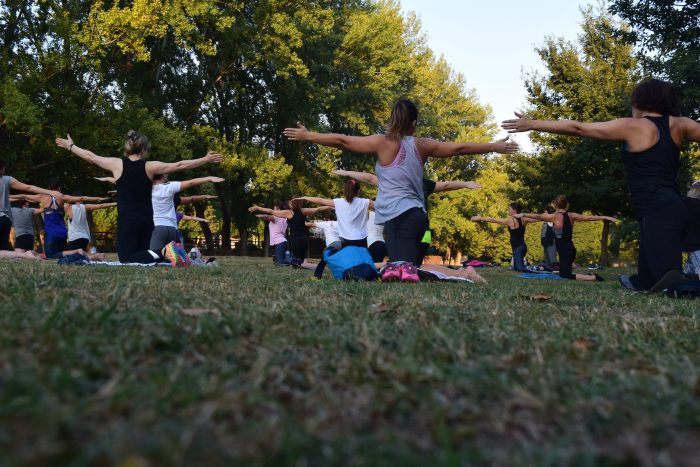In a recent yoga class, Kelly, our Little Gem Yoga instructor, started class by encouraging us to anchor into a supportive nature-based sound.
In our small sapphire-mining community, our yoga classes are held in a local park, directly opposite the appropriately-named Blue Gem Caravan Park. Just like our local sapphires, “the Blue Gem” is multi-faceted. It serves as the local fuel station, general store, and RV park.
During our Saturday morning yoga class, many human and mechanical sounds emanate from the Blue Gem. The chit chat of locals and visitors after they pay for fuel and breakfast. Engine noise and the revving of trucks and motorcycles.
At the start of yoga class, I find it far easier to anchor into human and mechanical sounds from the Blue Gem rather than the gentle sounds of our local wildlife.
What is anchoring?
Anchoring is another word for grounding. Anchors are used in yoga and meditative practices to help us focus our minds. They allow us to stay in the present moment. When we use anchors, we are less likely to be distracted. And when we are distracted (which happens to all of us), anchors allow us to more easily restore our focus.
In yoga practice, we tend to anchor in three ways: through our bodies, our breath and sound.
Body-based anchors bring our awareness to where our bodies touch the ground, through our feet, hands, and sit bones. We recognize where we feel tension, and allow that tension to be released.
Through our breath-based anchors, we feel the ebbs and flows of air within us. Breathing deeply in and out allows us to be more relaxed and present.
Our sound-based anchors are both internal and external. We can hear our rhythmic breathing within us. And during our yoga class, we choose the external sounds we wish to connect with, including bird songs and the wind rustling through the leaves.
Anchors are rituals
The use of anchors isn’t just restricted to yoga and meditative practices. We see them used in the sporting world as well.
During January, the height of our Australian summer, we are treated to four epic weeks of tennis tournaments, a glorious display of athletic prowess from the world’s best tennis players.
Rafael Nadal, my tennis hero, has several elaborate anchoring practices he uses in competition. His most famous ritual he executes with precision, just before he serves the ball.
Every. Single. Time.
He adjusts his shorts, touches his shoulders, cheeks, nose and forehead in a complicated routine that allows him to center his energy within. And from that anchored space, he serves the ball.
Some describe his rituals as bizarre; others call them on-court sacraments. Regardless of our opinions, Nadal’s rituals clearly work. They allow him to remain present, mentally tough, and intensely focused.
Nadal attributes his ability to control his emotions on the court to his regular meditation and yoga practices. His record speaks for itself; he has never smashed a tennis racket. I find his self mastery more impressive than his almost unrivaled list of tennis achievements.
Anchors are powerful!
But we need to choose them wisely. Like Nadal on the tennis court, we want to anchor into supportive energies.
If we’re not careful, we can too easily resonate with anchors that are less-than-beneficial.
How often have I fallen into the trap of anchoring into social media? And obsessing about the number of likes I’ve received on my Facebook posts? More times than I care to admit.
It is far better for me to anchor into what emotionally supports my personal essence, spirit and values.
There are many ways to anchor into what is good for us. And to role model that for our loved ones and clients too. I constantly look for ways to use supportive anchors in my healing practice. My sound-based anchors are instrumental and solfeggio-frequency music. Even my most wound-up clients are relaxing within minutes after being soothed by my ambient relaxation playlist.
We can use anchors in all areas of our lives
Anchors can ground us as we begin our day, our personal time, our conversations, and our meetings. They support us during our day, as we mindfully transition between more yang-based activities, including work, and playing with our dogs, to more chilled yin-based pastimes, like relaxing in nature. And they focus our minds and attention in the evening as we end our daily activities.
At the conclusion of our yoga class each week, Kelly leads us in a final sound-based anchor. After taking a deep breath, we all sound the “Om” in unison. And she acknowledges us with a collective “Namaste Yogis” and a gentle bow.
It is a beautiful and fitting way to finish our yoga time, as we express our gratitude for our shared time together.
I’d like to leave you with a challenge. Take time to mindfully introduce one or two anchors into your life in a supportive and self-affirming way. It can be your New Year’s resolution for grounding and centering.
And see what happens!











Read 10 comments and reply